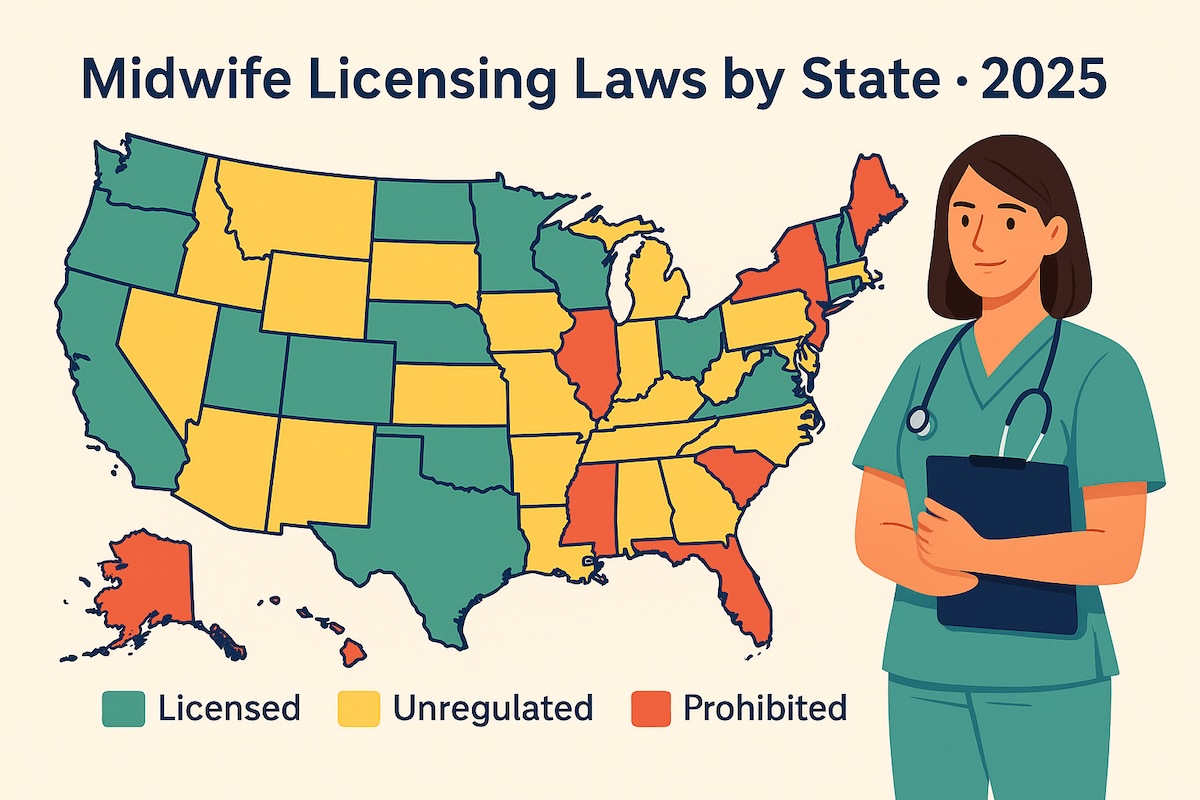Licensing laws vary dramatically by state, affecting everything from where a midwife can practice to whether Medicaid can reimburse them. For expectant parents, the legality and availability of midwifery services can depend entirely on geography. For aspiring midwives, the complexity of state licensure can limit or expand career options. Understanding these laws is essential for informed decisions on both sides.
Why Midwife Licensing Laws Matter
Organizations like the North American Registry of Midwives (NARM) and the National Association of Certified Professional Midwives (NACPM) continue advocating for state-level recognition, accountability, and Medicaid inclusion. Yet progress is slow, and midwives often face legal barriers, especially when practicing in out-of-hospital settings.
Types of Midwife Credentials
Midwifery licensing laws differ partly because there are multiple types of recognized midwives in the U.S., each with distinct education, certification, and scope of practice.
- Certified Nurse-Midwife (CNM): Registered nurses with graduate-level midwifery training, licensed in all 50 states, typically hospital-based but may practice in homes or birth centers.
- Certified Professional Midwife (CPM): Competency-based, out-of-hospital midwives certified by NARM. Not recognized in all states. Focuses on community birth settings.
- Certified Midwife (CM): Non-nurse midwives with similar graduate education as CNMs, licensed in a few states (e.g., NY, DE, NJ, ME, RI), certified by AMCB.
How States Classify Midwifery Licensing
States typically fall into one of four categories when it comes to midwife licensure:
| Licensing Status | Description | Example States |
|---|---|---|
| Regulated & Licensed | State licensure is available for CPMs with recognized education and certification. | Maryland, Oregon, Washington, Texas |
| Partially Regulated | Midwives may be licensed but with heavy restrictions or only via nurse-midwife credentials. | Illinois, Florida, Michigan |
| Unregulated | No formal pathway to licensure; midwifery may operate in a legal gray area. | North Carolina, Georgia |
| Prohibited | CPM practice is explicitly outlawed or considered a misdemeanor/felony. | Alabama, Nebraska |
Medicaid Coverage for Midwifery Services
One of the most significant barriers to equitable midwifery access is Medicaid reimbursement. While CNMs are reimbursed in all 50 states, CPMs are only covered by Medicaid in 14 states as of 2025.
- States with Medicaid Coverage for CPMs: Alaska, Arizona, Colorado, Montana, New Hampshire, New Mexico, Oregon, South Carolina, Texas, Utah, Vermont, Washington, Wisconsin, Minnesota
- Reimbursement rules vary; some states limit coverage to specific settings (e.g., birth centers only).
Trends in Midwife Advocacy
Licensing laws are slowly evolving thanks to advocacy by national and grassroots organizations. NACPM, Citizens for Midwifery, and state coalitions actively lobby for CPM licensure, Medicaid parity, and legal clarity. Their efforts have resulted in recent victories in states like Rhode Island, Michigan, and Delaware.
Still, significant gaps remain, especially in the South, where opposition from hospital lobbies and some physician groups has stalled legislative progress.
What Aspiring Midwives Should Know
Before choosing a certification path, it’s essential to understand which credentials are recognized in your state and whether your desired practice setting is legal.
To explore specific state requirements, visit our State-by-State CNM Licensing Guide.
Disclaimer
This article is for informational purposes only. It does not constitute legal or medical advice. Please check with your state licensing board for the most current midwifery laws.
Frequently Asked Questions
What’s the difference between a CNM, CPM, and CM?
CNMs are registered nurses with graduate midwifery training licensed in all 50 states. CPMs are trained to attend out-of-hospital births and are not recognized everywhere. CMs are non-nurses with similar graduate training as CNMs, licensed in a few states.
Which states allow certified professional midwives to practice legally?
CPMs are licensed or regulated in over 35 states, including Oregon, Texas, Maryland, and Washington. Other states remain unregulated or restrict CPM practice entirely.
Can CPMs get reimbursed by Medicaid?
As of 2025, 14 states reimburse CPMs through Medicaid, though rules vary by state and setting. CNMs are reimbursed in all 50 states.
Why do some states prohibit midwifery licensure?
Opposition is often based on safety concerns related to home births, as well as lobbying by medical organizations that favor hospital-based delivery models.
How can I find out if midwifery is legal in my state?
You can visit your state’s Board of Health or Professional Licensure office.





